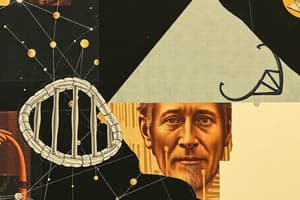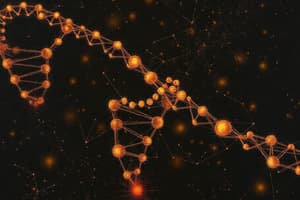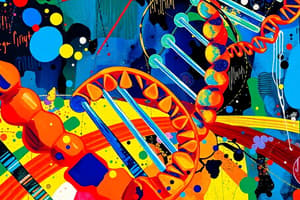Podcast
Questions and Answers
What is the significance of the double helix structure of DNA?
What is the significance of the double helix structure of DNA?
- It protects the cell from pathogens.
- It is involved in photosynthesis.
- It determines hereditary patterns in living things. (correct)
- It helps in the formation of proteins.
Oswald Avery was the first to discover the structure of DNA.
Oswald Avery was the first to discover the structure of DNA.
False (B)
What significant structure did James Watson co-discover?
What significant structure did James Watson co-discover?
- RNA molecule
- Cell membrane composition
- Protein synthesis process
- Double helix structure of DNA (correct)
James Watson completed his PhD in zoology.
James Watson completed his PhD in zoology.
Who are the scientists credited with discovering the double helix structure of DNA?
Who are the scientists credited with discovering the double helix structure of DNA?
The discovery of DNA's double helix structure led to advances in __________ and genetic engineering.
The discovery of DNA's double helix structure led to advances in __________ and genetic engineering.
In which year did James Watson start leading the Human Genome Project?
In which year did James Watson start leading the Human Genome Project?
Match the following individuals with their contributions to DNA research:
Match the following individuals with their contributions to DNA research:
James Watson was a key figure in the discovery of the double helix structure of _____.
James Watson was a key figure in the discovery of the double helix structure of _____.
Match the following milestones with their corresponding years:
Match the following milestones with their corresponding years:
What significant discovery is Francis Crick known for?
What significant discovery is Francis Crick known for?
Francis Crick completed his PhD in the same year he discovered DNA's structure.
Francis Crick completed his PhD in the same year he discovered DNA's structure.
Which laboratory did Francis Crick start his PhD at?
Which laboratory did Francis Crick start his PhD at?
In 1966, Crick described the genetic code as 'the key to _______ biology.'
In 1966, Crick described the genetic code as 'the key to _______ biology.'
Match the year with the corresponding milestone in Francis Crick's career:
Match the year with the corresponding milestone in Francis Crick's career:
What field did Crick study after moving to California?
What field did Crick study after moving to California?
Crick was awarded the Nobel Prize in 1962.
Crick was awarded the Nobel Prize in 1962.
What prestigious society awarded Crick for his contributions in 1972 and 1975?
What prestigious society awarded Crick for his contributions in 1972 and 1975?
What significant process did Sydney Brenner discover in 1961?
What significant process did Sydney Brenner discover in 1961?
Sydney Brenner was awarded a Nobel Prize in 2002 for his work on brain development.
Sydney Brenner was awarded a Nobel Prize in 2002 for his work on brain development.
What essential structure did Watson and Crick develop based on insights from other scientists?
What essential structure did Watson and Crick develop based on insights from other scientists?
The four bases of DNA are adenine, thymine, guanine, and _____ .
The four bases of DNA are adenine, thymine, guanine, and _____ .
Match the following scientists with their contributions to DNA research:
Match the following scientists with their contributions to DNA research:
How long did it take for Brenner and his team to develop their DNA model?
How long did it take for Brenner and his team to develop their DNA model?
The final DNA model was built in only 3 days.
The final DNA model was built in only 3 days.
What did Francis Crick famously state upon discovering DNA's structure?
What did Francis Crick famously state upon discovering DNA's structure?
What significant project did Maurice Wilkins work on during World War II?
What significant project did Maurice Wilkins work on during World War II?
Rosalind Franklin was awarded the Nobel Prize in 1962 for her contributions to DNA research.
Rosalind Franklin was awarded the Nobel Prize in 1962 for her contributions to DNA research.
What was the amount of the grant Rosalind Franklin received for her study of the polio virus?
What was the amount of the grant Rosalind Franklin received for her study of the polio virus?
Maurice Wilkins became director of King's College biophysics unit in __________.
Maurice Wilkins became director of King's College biophysics unit in __________.
Match the scientist with their notable contribution:
Match the scientist with their notable contribution:
What did Rosalind Franklin produce that was crucial for the discovery of DNA's structure?
What did Rosalind Franklin produce that was crucial for the discovery of DNA's structure?
Erwin Chargaff discovered that the bases A and T do not have equal ratios.
Erwin Chargaff discovered that the bases A and T do not have equal ratios.
Who were the three scientists awarded the Nobel Prize in Physiology or Medicine in 1962 for their work on DNA?
Who were the three scientists awarded the Nobel Prize in Physiology or Medicine in 1962 for their work on DNA?
The DNA double helix is often compared to a twisted __________.
The DNA double helix is often compared to a twisted __________.
Match the following scientists to their contributions or observations regarding DNA:
Match the following scientists to their contributions or observations regarding DNA:
What did Watson and Crick use to create their famous 3D DNA model?
What did Watson and Crick use to create their famous 3D DNA model?
What is the main area of research for James Watson?
What is the main area of research for James Watson?
Franklin's role in the discovery of DNA was fully acknowledged during her lifetime.
Franklin's role in the discovery of DNA was fully acknowledged during her lifetime.
Francis Crick was awarded the Nobel Prize in 1962 for his discovery related to DNA.
Francis Crick was awarded the Nobel Prize in 1962 for his discovery related to DNA.
What significant structure did James Watson receive recognition for discovering?
What significant structure did James Watson receive recognition for discovering?
In what year did Crick and Watson complete their model of DNA?
In what year did Crick and Watson complete their model of DNA?
In 1966, Crick described the genetic code as 'the key to _______ biology.'
In 1966, Crick described the genetic code as 'the key to _______ biology.'
Match the following notable figures in DNA research with their contributions:
Match the following notable figures in DNA research with their contributions:
What did Franklin propose about the structure of DNA based on Photograph 51?
What did Franklin propose about the structure of DNA based on Photograph 51?
Maurice Wilkins showed Photograph 51 to Crick and Watson without informing Franklin.
Maurice Wilkins showed Photograph 51 to Crick and Watson without informing Franklin.
What groundbreaking model did Franklin propose after moving to Birkbeck College?
What groundbreaking model did Franklin propose after moving to Birkbeck College?
Franklin produced Photograph 51, which was the first clear image of the __________ structure of DNA.
Franklin produced Photograph 51, which was the first clear image of the __________ structure of DNA.
Match the following scientists with their contributions to DNA research:
Match the following scientists with their contributions to DNA research:
What degree did Rosalind Franklin earn from the University of Cambridge?
What degree did Rosalind Franklin earn from the University of Cambridge?
Rosalind Franklin was recognized and awarded a Nobel Prize during her lifetime for her work on DNA.
Rosalind Franklin was recognized and awarded a Nobel Prize during her lifetime for her work on DNA.
In which year did Rosalind Franklin produce the first clear image of crystalline DNA?
In which year did Rosalind Franklin produce the first clear image of crystalline DNA?
Rosalind Franklin moved to Paris in 1947 to study ________.
Rosalind Franklin moved to Paris in 1947 to study ________.
Match the following years with the corresponding events in Rosalind Franklin's life:
Match the following years with the corresponding events in Rosalind Franklin's life:
Which of the following statements best describes Rosalind Franklin's role in the DNA race?
Which of the following statements best describes Rosalind Franklin's role in the DNA race?
Rosalind Franklin conducted major research on crop viruses after moving to Birkbeck College.
Rosalind Franklin conducted major research on crop viruses after moving to Birkbeck College.
Rosalind Franklin was born in ________.
Rosalind Franklin was born in ________.
Who was the first person to win two Nobel Prizes in Chemistry?
Who was the first person to win two Nobel Prizes in Chemistry?
John Sulston was a pioneer in sequencing the first human genome.
John Sulston was a pioneer in sequencing the first human genome.
What significant method did Sanger develop for sequencing DNA?
What significant method did Sanger develop for sequencing DNA?
In 1981, Sanger's team completed the sequencing of the first human __________.
In 1981, Sanger's team completed the sequencing of the first human __________.
Match the following scientists with their contributions:
Match the following scientists with their contributions:
What material did Sanger use to label DNA fragments for sequencing?
What material did Sanger use to label DNA fragments for sequencing?
The sequencing approach developed by Sanger enabled the isolation and cloning of DNA fragments.
The sequencing approach developed by Sanger enabled the isolation and cloning of DNA fragments.
What is the nematode worm that Sulston studied?
What is the nematode worm that Sulston studied?
Flashcards are hidden until you start studying
Study Notes
Francis Crick
- Crick was a British biophysicist who won the Nobel Prize for his co-discovery of the structure of DNA in 1953.
- He studied physics at University College London and worked for the Royal Navy during World War II.
- He later returned to Cambridge to pursue a PhD in biological sciences.
- He collaborated with James Watson at the Cavendish Laboratory in Cambridge.
- They unveiled DNA’s molecular structure together.
- He played a vital role in deciphering the structure of DNA.
- Crick focused on the genetic code and its role in molecular biology.
- He described the genetic code as "the key to molecular biology" in 1966.
- He moved to California in 1976 to study developmental neurobiology and human consciousness.
James Watson
- American geneticist and biophysicist who shared the Nobel Prize for his co-discovery of the double helix structure of DNA.
- He studied zoology at the University of Chicago.
- Watson completed his PhD in virus research.
- He moved to the Cavendish Laboratory in Cambridge, where he met and collaborated with Francis Crick.
- He returned to the Cavendish Laboratory to work with Crick on virus construction.
- He lectured at Harvard and became a biology professor.
- He wrote key biological texts.
- He led the international Human Genome Project in 1989, to map all the genes of a human chromosome.
DNA: A Remarkable Discovery
- The discovery of DNA's double helix structure revolutionized scientific understanding of heredity.
- DNA, or deoxyribonucleic acid, is the chemical substance within cells that determines hereditary patterns in all living things.
- Understanding DNA's structure led to understanding how it replicates and transmits genetic information.
- This provided crucial insight into how genes operate.
The Race to Discover DNA's Structure
- The discovery of DNA's double helix was the culmination of years of research by many scientists.
- Oswald Avery's research in 1944 showed that DNA carries genetic information but didn't fully delineate the precise structure.
- The race to uncover DNA's structure led to significant advancements in scientific methods, including gene sequencing and genetic engineering.
Sydney Brenner and the Discovery of DNA
- Sydney Brenner is a South African biologist who made crucial contributions to uncovering DNA's structure.
- Brenner completed his PhD at Oxford University.
- He conducted leading research in developmental genetics and molecular biology.
- Brenner’s work on organ development and cell apoptosis earned him a Nobel Prize in 2002.
- His 18 months of research led to a groundbreaking single-page paper on the DNA model.
- He completed a model of DNA in 3 days.
Unraveling the Secret of DNA
- Scientists struggled to determine DNA structure and replication until the 1950s.
- Linus Pauling, Rosalind Franklin, and Maurice Wilkins at King's College London played important roles, but did not fully understand DNA's structure.
- They understood that DNA had a backbone of phosphoric acid and sugar and four bases: adenine, thymine, guanine, and cytosine.
- It wasn't until the efforts of Francis Crick and James Watson that the structure of DNA was finally understood.
DNA Structure
- Rosalind Franklin’s X-ray photograph (Photograph 51) showed DNA's double helix structure.
- Franklin worked alongside Maurice Wilkins, and Wilkins showed Photograph 51 to Crick and Watson without Franklin’s knowledge.
- This image helped Crick and Watson confirm the double helix structure and complete their model.
- The DNA double helix resembles a twisted ladder, with the phosphoric acid and sugar strands forming the uprights of the ladder.
- Paired bases (A, T, C, and G) create the rungs of the ladder.
- The order of these bonded bases forms the genetic code.
- When the ladder splits, each half bonds with newly formed DNA components to create two new, identical double helix structures
Rosalind Franklin
- British chemist whose X-ray diffraction images were crucial to determining the double helix structure of DNA.
- Franklin studied the structure of coal and graphite.
- Franklin specialized in X-ray crystallography and used it to study the structure of DNA.
- Franklin’s image helped Watson and Crick confirm the double helix structure of DNA, but her contributions were not fully recognized during her life.
Maurice Wilkins
- British biophysicist who shared the Nobel prize for his X-ray diffraction studies of DNA.
- He used X-ray imaging to study DNA fibers.
- He was part of the King's College, London research team working on DNA structure.
The Nobel Prize in Chemistry and DNA Sequencing
- Frederick Sanger was the first person to win two Nobel Prizes in Chemistry.
- Sanger received the first in 1958 for his work on insulin.
- He developed a method for DNA sequencing using radioactive isotopes to "label" fragments.
- He tracked overlaps between fragments to build up the complete sequence.
- His team developed a method for isolating DNA fragments quickly by using a molecule inhibitor to prevent DNA strands from extending and ordering the strands from shortest to longest to identify the base order.
- He helped sequence the first human genome in 1981.
John Sulston and the Worm
- The first director of the Wellcome Sanger Institute.
- Won the 2002 Nobel Prize for his work with the nematode worm (C.elegans).
- His research contributed to the understanding of cell division, differentiation, and death.
- He helped sequence the first animal genome.
Key Dates
- 1953: Crick and Watson's DNA double-helix discovery.
- 1958: Sanger's first Nobel Prize for work on insulin.
- 1950s: Franklin studied the crystalline structure of viruses including polio.
- 1967: Sanger's RNA sequencing.
- 1977: Sanger's dideoxy chain-termination method for sequencing DNA, still used today
- 1981: First human mitochondrial genome sequenced.
- 1988: First animal genome sequenced (C.Elegans).
- 1990-2003: The Human Genome Project.
Additional information
- 51 took 60 hours to produce.
- Franklin received a $13,000 grant for her polio virus study.
- She bequeathed $4,000 to support Aaron Klug in his work.
Studying That Suits You
Use AI to generate personalized quizzes and flashcards to suit your learning preferences.





